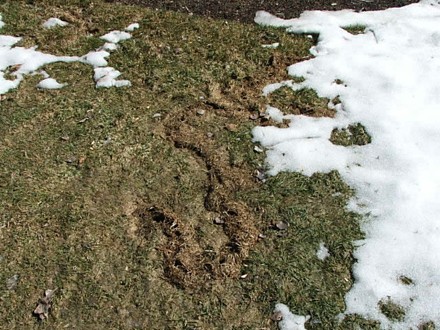Assessing Lawn Damage After Snow Melts
By Jos Van Hage

Voles can leave trails that look like a road map in your lawn
You often do not know what is happening under the snow until the snow melts in the spring. In lawns including my own I have noticed long runways or channels that are 2-3 inches wide where the grass has been dug up. This is caused by voles who over the winter months under the cover of snow will dig, eat, and nest their way through the lawn. Voles are very similar to mice but have a short tail, stocky body and are plant eaters. They can cause some damage to the lawn which is easily repaired.
Wait till the grass and soil have dried before working on the lawn and then rake up the dead debris and lightly top dress the area with some good quality outdoor soil to fill in any uneven patches that have occurred. The grass should quickly fill in and if there is a lot of damage you may want to reseed the area.
Something else that can be uncovered by melting snow is ‘snow mold’. Snow mold appears as the snow melts from the lawn and it looks like fine cobwebs or cotton fluff that is on the surface of the dead matted grass blades. It is either pinkish or white/grey. It is a cold weather disease that becomes active when the temperatures are just around freezing and conditions are moist. It can occur when there are heavy snows that fall on unfrozen ground or in areas that are shaded or wet because it takes longer for the snow to melt. It can also occur in areas where the snow has been piled up and compacted which will lengthen the time it takes for the snow to melt and in this case you can use a shovel to spread out the snow so that it melts more quickly.
If you have snow mold it is really nothing to worry about as it seldom kills the grass and once the area is dry the mold will stop and the grass will grow again. Affected areas may take a little longer to green up so by giving that area a little extra care by applying some fertilizer and enough water to help it recover more quickly will be helpful.
As the snow melts it can reveal areas in the lawn where salt was used over the winter months for melting and controlling ice on walkways, roads etc., as well as pet urine from an animal relieving itself in the same area. This can cause damage to the soil preventing plants from growing if left untreated. There is a product called ‘Salt Stopper’ which is naturally-mined Calcium Magnesium Sulphate that is an excellent neutralizer for exactly this problem. Wait till the soil and grass is dry and then rake out as much of the thatch as possible. Next shake the Salt Stopper over the area following the directions on the bag and water it in. This should neutralize the soil and prevent any further damage.
-Jos
Jos Van Hage owns and operates two Art Knapp Home and Garden Centres in Prince George,
- Highway 16 west at Kimball Road
- Highway 97 North at Northwood Pulpmill Road
Previous Story - Next Story
Return to Home










cheers Jos